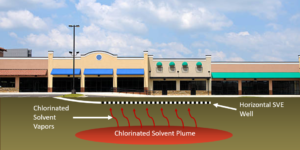What is Soil Vapor Intrusion and How Can it Be Prevented?
The phrase soil vapor intrusion refers to the process by which volatile chemicals move from a subsurface source into the indoor air of overlying buildings. Soil vapor can become contaminated when chemicals evaporate from subsurface sources and enter the vadose zone. Vapor intrusion can be a concern at sites contaminated with solvents and other vapor-forming chemicals. When contaminated vapors are present in the zone directly next to or under a building, vapor intrusion is possible. If uncontrolled, chemical vapors can enter buildings, affecting indoor air quality and potentially posing a risk to the health of building occupants. There are various methods to deal with soil vapor intrusion which include; vapor barriers, soil vapor extraction (SVE), sub-slab depressurization (SSDS), bioventing, passive venting, and more. These methods are implemented beneath the building footprint and prevent vapors from ever entering the building interior.What Are the Advantages of Using Horizontal Wells to Prevent Soil Vapor Intrusion?
 What Are the Advantages of Using Horizontal Wells to Prevent Vapor Intrusion?
What Are the Advantages of Using Horizontal Wells to Prevent Vapor Intrusion?
Vertical wells are the most common method to install in-situ vapor intrusion mitigation measures. However, various site limitations can make vertical wells challenging to implement effectively. Common site conditions which limit the efficacy of vertical wells include lack of access to the area above the plume due to infrastructure or sensitive areas, industrial, commercial, residential uses of the property which cannot easily tolerate interruptions during remedial construction, and O&M, challenging geology, and future site redevelopment. Horizontal remediation wells can be used to implement soil vapor extraction (SVE), sub-slab depressurization (SSDS), bioventing, and passive venting remediation strategies to prevent vapor intrusion. Horizontal remediation wells are frequently utilized to overcome these site conditions and install remediation systems. Horizontal remediation wells can be used to implement soil vapor extraction (SVE), sub-slab depressurization (SSDS), bioventing, and passive venting remediation strategies to prevent vapor intrusion. Unlike conventional vertical remediation wells, horizontal remediation wells can access the contaminant plume from almost anywhere through the use of directional drilling techniques. Not only do horizontal remediation wells allow you to access the plume, they are also far more effective at cleaning up contamination. A horizontal remediation well screen allows significantly more contact with the contaminant plume, allowing for more efficient treatment of wider areas of the subsurface and thorough coverage of the building footprint to prevent vapor intrusion. They can also be precisely targeted to focus on problematic hot spots. The resulting radius of influence that can be achieved by horizontal remediation wells allows for enhanced remediation performance and better management of the factors which cause vapor intrusion.
There are various effective ways to utilize horizontal remediation wells to address vapor intrusion. Horizontal remediation techniques such as soil vapor extraction (SVE), sub-slab depressurization (SSDS), bioventing, and passive venting are proven to prevent vapor intrusion by providing unparalleled access to the contaminant plume and enhanced treatment of soil vapor. If you have a contaminated site with vapor intrusion concerns, please click HERE to tell us about your project so that we can help you determine whether horizontal remediation wells may be an effective solution.